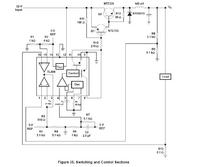me_guitarist
Full Member level 6

Re: DC to DC converter
Recently just reviewed the TL494 app note & tried to construct the given example. Couldn't get the original PNP & NPN transistor so I replaced with BD911 & BD912 respectively. My current inductor are about 60uH, output cap is 100V 220uF x 2, setting output voltage to 7.2V ( for my DC powered hand drill which rated 10A@7.2V ).
Others component are similar to SLVA001D app note, but I get about 1v drops on 6A loading. was this normal???
My input are 24VDC.
Also, the sensing resistor are on the GND side, how can I move to Vout for over current protection???

Thanks in advance!
Recently just reviewed the TL494 app note & tried to construct the given example. Couldn't get the original PNP & NPN transistor so I replaced with BD911 & BD912 respectively. My current inductor are about 60uH, output cap is 100V 220uF x 2, setting output voltage to 7.2V ( for my DC powered hand drill which rated 10A@7.2V ).
Others component are similar to SLVA001D app note, but I get about 1v drops on 6A loading. was this normal???
My input are 24VDC.
Also, the sensing resistor are on the GND side, how can I move to Vout for over current protection???

Thanks in advance!



